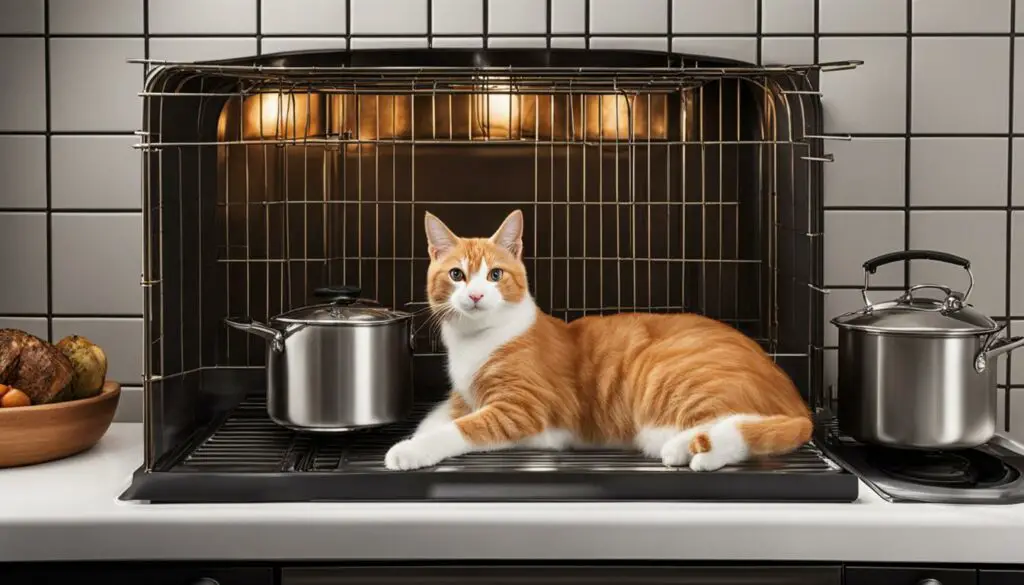Greetings, fellow cat owners! Today, I’m here to share some effective tips on how to keep your furry friend off the stove and ensure their safety in the kitchen. Cats can be curious creatures, and while many of them know to stay away from hot stoves, some may still venture onto these dangerous surfaces, putting themselves at risk of injury. But fret not, because I have some practical solutions to help you create a cat-friendly kitchen and prevent your feline companion from accessing the stove.
Understanding cat behavior is the first step in finding the right strategies to deter them from jumping on the stove. By implementing these proven training techniques and cat-proofing methods, you can create a safer environment for your cat while maintaining kitchen safety.
Key Takeaways:
- Placing sticky placemats on the counter can deter cats from jumping on it.
- The smell of citrus can discourage cats from approaching the stove.
- Layering aluminum foil on the stove and countertops can discourage cats from jumping on them.
- Blocking common landing areas with objects can discourage cats from accessing the counter.
- Using cookie sheets close to the edge of the counter can provide an uncomfortable landing for cats.
With these tips and techniques, you can create a cat-friendly kitchen and keep your furry friend safe. Remember, consistency and patience are key when training cats. So, let’s embark on this journey together and make your kitchen a safe and cozy space for both you and your beloved feline companion.
Place Mats on the Counter
One effective method to deter cats from jumping on the kitchen counter is to place sticky placemats on the surface. Cats do not like the feel of the sticky mats and will be discouraged from jumping up. The mats can be left on the counter until the cat stops trying to jump on it, at which point they can be removed.
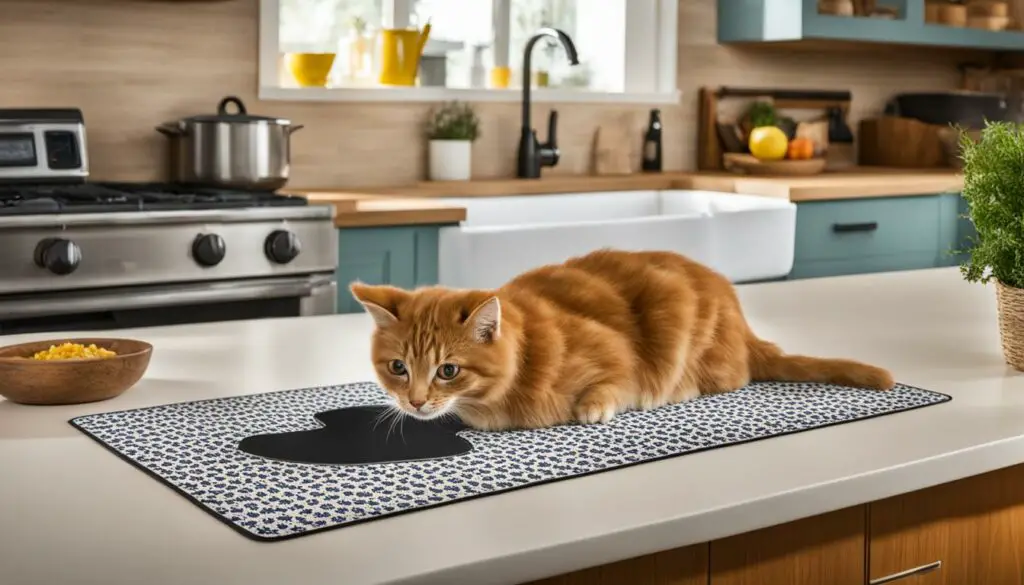
This simple cat-proofing solution is easy to implement and does not require any special training techniques. By making the counter surface less appealing, you can redirect your cat’s attention to more appropriate areas in the house.
Deter Cats from Jumping on the Counter with Sticky Placemats:
- Choose sticky placemats that are safe for your counters and easy to clean.
- Place the mats strategically on the counter, covering the areas where your cat is most likely to jump.
- Observe your cat’s behavior and monitor their response to the sticky mats.
- Once your cat learns to avoid the counter, you can gradually remove the mats.
Remember, consistency is key when using this method. It may take some time for your cat to understand that the counter is off-limits. Be patient and provide alternative climbing areas and stimulation to redirect their behavior.
| Pros | Cons |
|---|---|
|
|
Use a Citrus Cleaner
Cats are often deterred by the smell of citrus. The scent of citrus can help keep them away from the stove, preventing any potential accidents or injuries. One effective method is to use a citrus-scented cleaner in the kitchen. Cats do not appreciate the strong smell of citrus, and it can discourage them from approaching the stove.
When choosing a citrus cleaner, it is best to opt for one that includes real citrus ingredients rather than artificial scents. This ensures that the smell is authentic and potent. If you prefer a natural option, you can make your own citrus cleaner using orange peels or similar ingredients. Simply steep the peels in vinegar or water for a few days, strain the liquid, and use it as a cleaning solution. This not only helps keep your cat off the stove but also leaves your kitchen smelling fresh and citrusy.
Remember to use the citrus cleaner regularly to maintain the scent and effectiveness. Clean the stove and surrounding areas with the citrus-scented cleaner as part of your regular cleaning routine. This will help reinforce the association between the scent and the stove, further deterring your cat from approaching it. With consistent use, a citrus cleaner can be a valuable tool in keeping your cat safely away from the stove.
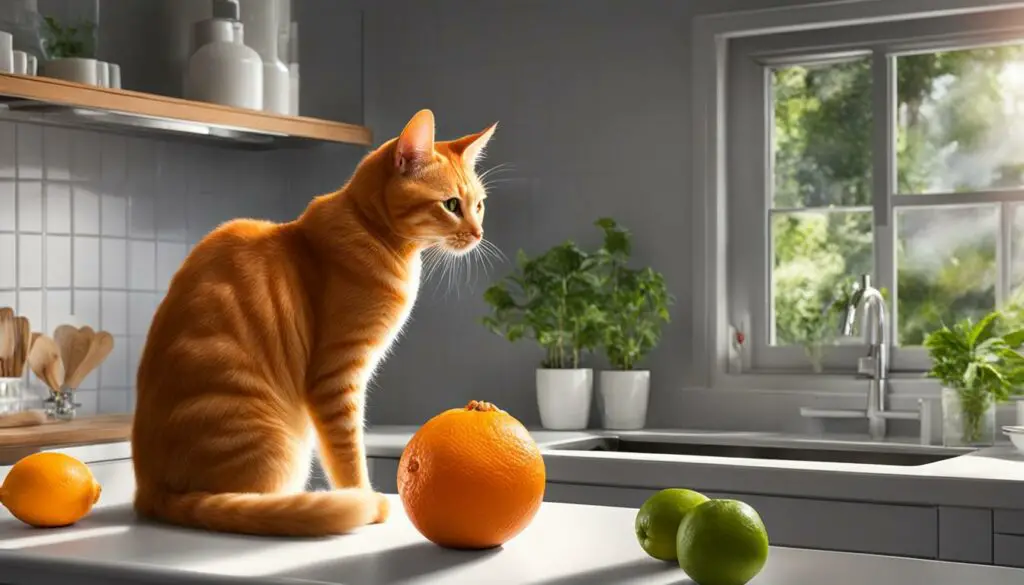
Tip: Create a Citrus Spray
Another way to utilize the power of citrus to deter cats from the stove is by creating a citrus spray. Simply combine fresh citrus juice with water in a spray bottle and shake well. Then, spritz the mixture around the stove and countertop. The strong citrus scent will discourage your cat from venturing near these areas. Be sure to test the spray on a small, inconspicuous area first to ensure it does not cause any damage.
Using a citrus-scented cleaner can be an effective and natural way to keep your cat off the stove. The strong smell of citrus is often unpleasant to cats, making them less likely to approach the stove and potentially injure themselves. Consider incorporating a citrus cleaner into your cleaning routine in order to create a cat-friendly kitchen environment.
Use Aluminum Foil
If you’re looking for a simple and effective way to deter your cat from jumping on the stove, try using aluminum foil. Cats dislike the feel and sound of aluminum foil on their paws, making it an excellent deterrent.
To use aluminum foil as a cat deterrent, simply layer it on the stove and countertop. The shiny surface and crinkly texture will discourage your cat from jumping on these surfaces. Be sure to securely cover the entire area to eliminate any tempting spots. Remember to remove the foil before using the stove to prevent any safety hazards.
Using aluminum foil is a safe and non-toxic method to prevent cats from accessing the stove. It is a temporary solution that can be effective in training your cat to stay off the stove. However, keep in mind that some cats may adapt and find alternative ways to access the countertop or stove. In such cases, combining aluminum foil with other deterrents and training techniques may be necessary to reinforce the desired behavior.
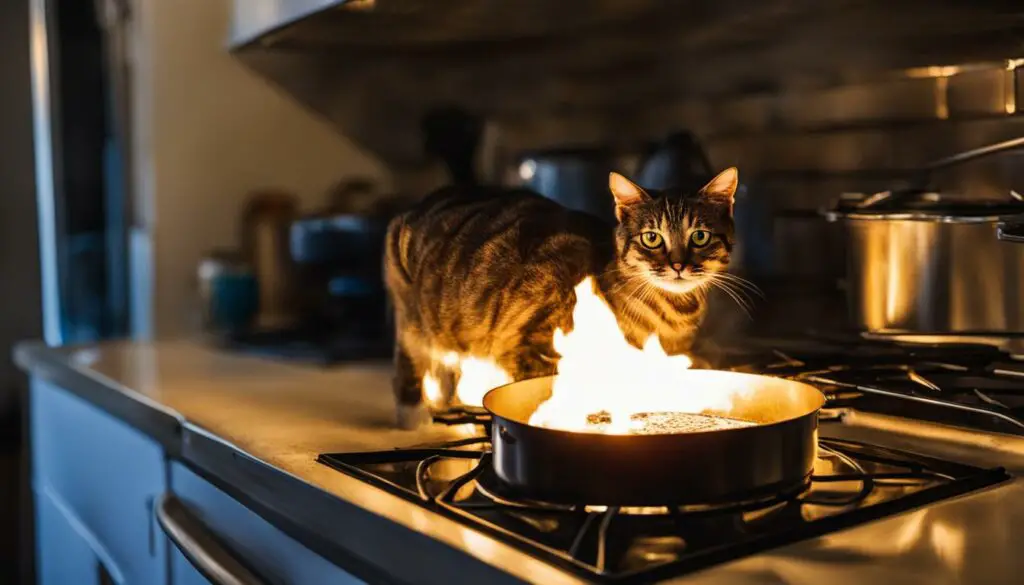
Other Tips and Techniques to Consider
- Place sticky placemats on the counter to deter cats from jumping on it
- Use a citrus-scented cleaner to keep cats away from the stove
- Block common landing areas on the counter with objects or obstacles
- Provide alternative climbing areas, such as cat trees or climbing structures
- Spend quality time with your cat to meet their attention needs
- Provide extra stimulation with toys and puzzle toys to distract cats from jumping on the counter
- Remove food and enticing items from the counter to eliminate the temptation for your cat
- Redirect your cat’s behavior and provide consequences for jumping on the counter
- Consistently reinforce the desired behavior and prevent your cat from accessing the counter
Summary
Using aluminum foil is a practical and affordable method to deter cats from jumping on the stove. By layering it on the stove and countertop, you can create an unpleasant surface that cats dislike. However, it’s important to combine this technique with other deterrents and training methods to effectively prevent cats from accessing the stove and ensure their safety in the kitchen.
Block Common Landing Areas
If your cat has a specific spot on the counter where it likes to jump, you can block it to deter them from landing there. One effective method is to obstruct their favorite counter spot with a strategically placed object, such as a fruit bowl or a decorative item. By preventing their access to this preferred location, you can discourage them from jumping on the counter.
Blocking common landing areas serves as a physical barrier that disrupts your cat’s jumping routine. It forces them to find an alternative spot, which may deter them altogether. However, it is important to note that some persistent cats may simply find another way to get on the counter, so additional measures may be necessary.
Consider experimenting with different objects or rearranging items in your kitchen to obstruct various counter areas. By changing the layout and blocking multiple jumping spots, you increase the chances of discouraging your cat from landing on the counter.
Table: Examples of Objects to Block Common Landing Areas
| Object | Description |
|---|---|
| Fruit bowl | A decorative bowl filled with fresh fruits that covers the desired counter spot. |
| Cookbook stand | A stand placed at the edge of the counter to create an obstacle for your cat. |
| Plants | Tall plants strategically positioned to obstruct the landing area on the counter. |
| Decorative tray | A stylish tray placed over the desired spot, making it less accessible for your cat. |
Be creative and experiment with different objects to find what works best for your cat. Remember to choose items that are safe and stable, ensuring they won’t pose any danger to your feline friend. With persistence and the right combination of objects, you can effectively deter your cat from landing on the counter.
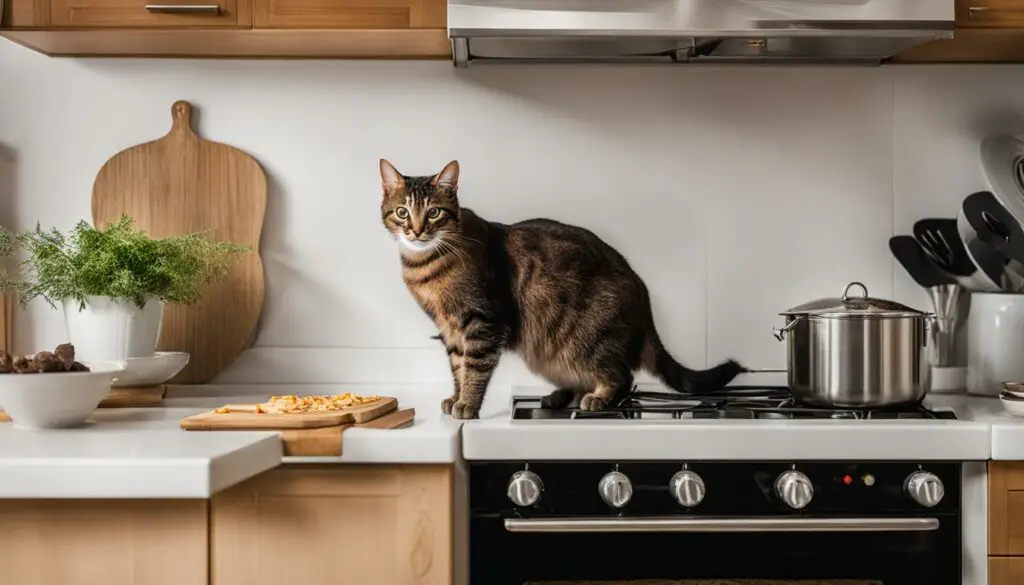
Creating a cat-friendly kitchen involves using various methods to prevent your furry friend from jumping on the counter. Blocking common landing areas is an effective way to discourage this behavior and promote a safe environment. By strategically placing objects and rearranging your kitchen layout, you can inspire your cat to find alternative spaces while keeping your countertops free from unwanted feline visitors.
Use Cookie Sheets
When it comes to keeping cats off the stove, cookie sheets can serve as an effective deterrent. Placing cookie sheets near the edge of the stove creates an uncomfortable landing spot for cats, making them less likely to jump up. The sound and texture of the metal can startle them, reinforcing the idea that the stove is not a desirable place to be.
While cookie sheets can be a great alternative to foil or tape, it’s important to note that not all cats will be deterred by them. Some cats may become accustomed to the cookie sheets over time, rendering them less effective. If this is the case, it may be necessary to explore other methods to keep your cat off the stove.
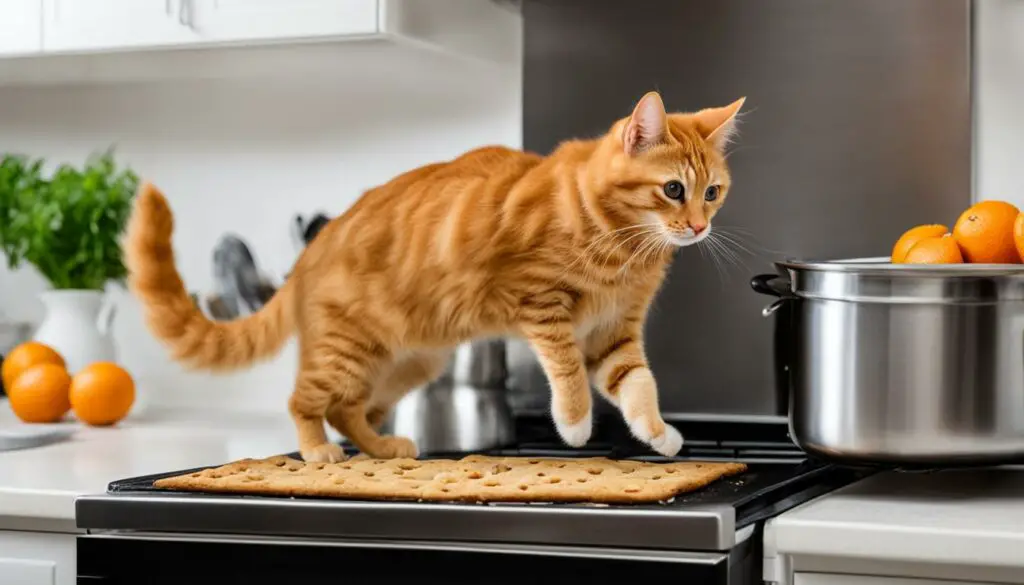
Cat Climbing Structures to Prevent Cats from Using the Counter for Climbing
When cats have a natural instinct to climb, providing them with alternative climbing areas can prevent them from using the counter and stove as their favorite spots. Cat climbing structures, such as cat trees, are a great way to redirect their climbing behavior and keep them entertained.
By offering your cat a dedicated space to climb and explore, you can discourage them from jumping on the counter. Cat trees provide vertical space for cats to climb, perch, and even play. They often come with scratching posts, hideaways, and interactive toys, which can further engage your cat’s natural instincts.
Placing the cat tree near a window allows your feline friend to enjoy a view while also keeping them occupied. Cats love to observe their surroundings, and having a cat tree near a window gives them the opportunity to do so without getting on the counter or stove.
Investing in a high-quality cat climbing structure not only provides an outlet for your cat’s climbing behavior but also gives them a sense of ownership and territory. It can help create a cat-friendly environment in your home, ensuring a happy and fulfilled feline companion.
| Benefits of Cat Climbing Structures | Examples of Popular Cat Trees |
|---|---|
|
|
Testimonial: A Happier Cat with a Cat Tree
“Purchasing a cat tree was the best decision I made for my curious and adventurous cat. She used to be constantly on the counter, but ever since we got the cat tree, she spends most of her time exploring and playing on it. It has not only kept her off the counter but has also provided her with endless entertainment. I highly recommend investing in a cat tree for any cat owner!”
– Cat Lover123
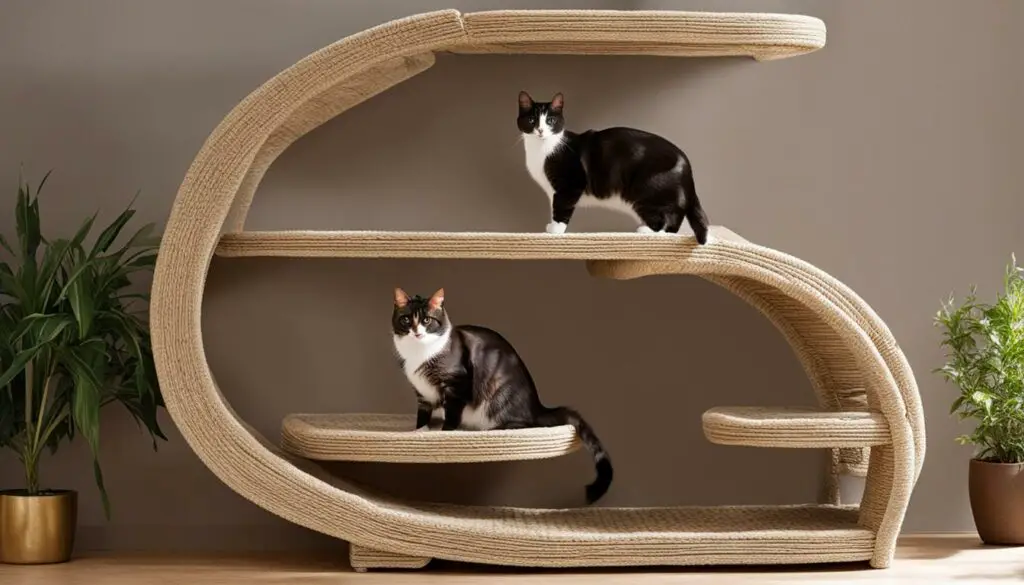
By providing cat climbing structures like cat trees, you can discourage your feline friend from using the counter for climbing. Investing in a sturdy and engaging cat tree offers a dedicated space for climbing, playing, and observing the world from a safe height. Not only will this prevent your cat from accessing the counter, but it will also provide mental and physical stimulation, leading to a happier and healthier cat.
Spend Time With Your Cat
When it comes to preventing your cat from jumping on the stove, one of the most effective strategies is to spend quality time with your feline friend. Cats often seek attention and affection, and providing them with ample interaction can help redirect their focus away from countertop exploration.
By dedicating time each day to play, cuddle, and engage with your cat, you can fulfill their need for attention and stimulation. This will create a strong bond between you and your pet, making them less likely to engage in counter-jumping behavior.
During your interaction with your cat, make sure to provide enriching activities that capture their interest. Engage them with interactive toys, laser pointers, or puzzle games that require problem-solving. This will not only distract them from the allure of the stove but also provide mental stimulation, keeping them entertained and fulfilled.
Remember, cats are intelligent creatures, and they thrive on mental and physical stimulation. By dedicating time and attention to your cat’s needs, you can effectively prevent stove-jumping behavior and create a harmonious and cat-friendly kitchen environment.
Provide Extra Stimulation
Keeping cats entertained and mentally stimulated is an important aspect of preventing them from jumping on the counter. By providing a variety of engaging toys, you can distract your cat from their countertop adventures. Cat toys, such as interactive wands, feather teasers, and puzzle toys, can keep them occupied and redirected from the counter. The use of puzzle toys is particularly effective as it challenges their problem-solving skills and keeps their minds engaged. These toys often require cats to think and work for their treats or rewards, providing both physical and mental stimulation.
One popular option is the treat-dispensing puzzle toy, where your cat has to figure out how to release the treats hidden inside. Not only does this distract your cat from the counter, but it also provides them with a fun and rewarding activity. Alternatively, you can make your own puzzle toys using everyday items like cardboard boxes or toilet paper rolls. Fill them with treats or catnip to entice your furry friend and watch as they engage in playful exploration.
It’s important to note that different cats have different preferences when it comes to toys. Some cats may be more interested in interactive toys that require human involvement, while others may prefer independent play with ball toys or plush mice. Observe your cat’s behavior to identify which toys they are most attracted to and tailor their playtime accordingly. Remember to rotate their toys regularly to keep them continuously engaged and prevent boredom.
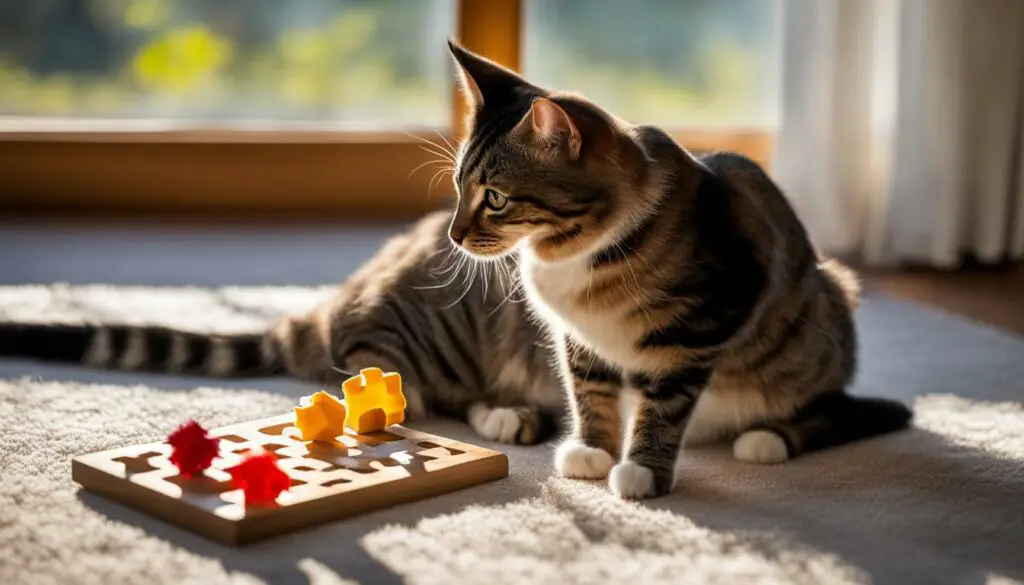
Distracting Quotes:
“Providing stimulating toys not only keeps your cat mentally engaged but also helps redirect their attention away from the counter and stove.” – Cat Behavior Expert
“Toys that mimic prey, such as feather teasers or interactive wands, can help satisfy your cat’s hunting instincts and prevent countertop jumping.” – Feline Behavior Specialist
Tables:
| Name | Description | Price |
|---|---|---|
| Interactive Wand | A wand toy with feathers or toys attached to a string, providing an interactive play experience for cats. | $10 |
| Puzzle Feeder | A toy that dispenses treats or kibble, requiring cats to problem-solve and work to access their food. | $15 |
| Ball Tower | A toy with multiple levels and tracks where cats can bat and chase balls for hours of entertainment. | $20 |
Integrating these toys into your cat’s daily routine can help keep them mentally stimulated and prevent them from seeking excitement on your kitchen counters. Remember, cats thrive on both mental and physical stimulation, so incorporating playtime and interactive toys into their daily schedule is essential for their overall well-being.
Prevent Cats from Accessing Food on the Stove
When it comes to cat-proofing your kitchen, one important aspect is to remove food from counters and prevent cats from accessing food on the stove. Cats are naturally curious and may be attracted to the smell of food, making it essential to take measures to keep them away.
Keep Counters Clear of Food
To create a cat-proof kitchen, it is crucial to clear the counters of any food items. This includes leftover meals, packaged goods, fruits, and dry herbs. Even if you think your cat won’t be interested, it’s best to err on the side of caution. Leaving food unattended can be tempting for cats and may lead to them jumping on the counter or stove in search of a snack.
Store Food Properly
In addition to keeping countertops clear, it’s important to store food properly to prevent cats from accessing it. Make sure all food items are stored in sealed containers or kept in secure cabinets. Avoid leaving food uncovered or using packaging that can be easily opened by a curious feline. By taking these precautions, you can reduce the chances of your cat being able to reach and potentially eat food from the stove or counter.
Use Cat Deterrents
In some cases, simply removing food may not be enough, especially if your cat has developed a habit of counter-surfing. In such situations, there are cat deterrents that can be used to discourage them. For instance, you can try using a pet-safe spray that has an odor cats find unappealing, such as citrus or bitter apple. Applying the spray on the stove or counters can create a scent barrier that cats may find unpleasant, thus preventing them from jumping up.
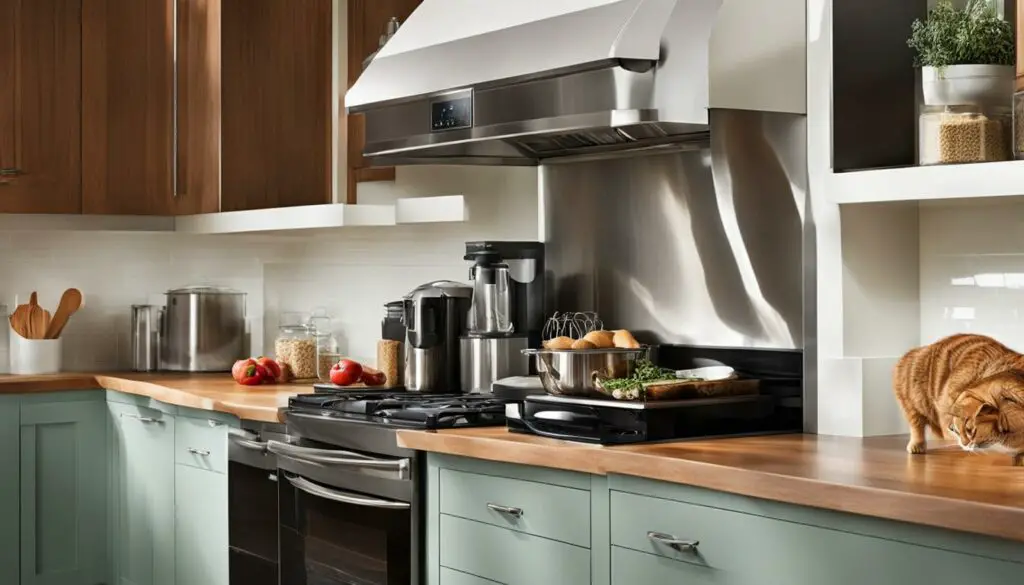
By implementing these strategies, you can create a kitchen environment that minimizes the chances of your cat accessing food on the stove. Remember to keep counters clear of food, store food properly, and use cat deterrents when necessary. These steps will help keep your furry friend safe and your kitchen free from any potential food-related mishaps.
Remove Your Cat From the Counter
When your cat jumps on the counter, it’s important to gently remove them and say “off.” This helps establish boundaries and lets them know that the counter is off-limits. Avoid pushing the cat, as this can lead to injuries or create a negative association. Instead, gently lift them off the counter, using a firm but gentle tone when saying “off.”
If your cat continues to jump on the counter despite your efforts, it may be necessary to physically prevent them from reaching it. This can be done by blocking their access with a baby gate or placing objects that create a barrier. If needed, you can also consider using a crate or closing them in a separate room for a brief period. This helps to redirect their behavior and reinforces the message that jumping on the counter is not allowed.
In addition to physically removing your cat from the counter, it’s important to avoid giving them attention immediately after the behavior. This includes scolding or yelling at them, as this attention, even negative, can reinforce the behavior. Instead, redirect their attention to a more appropriate activity or reward them for behaving appropriately elsewhere. Over time, this consistency will help deter them from jumping on the counter altogether.
Consequences for Counter-Jumping
It’s important to establish consequences for counter-jumping to discourage the behavior. One effective consequence is the use of noise deterrents. Cats are sensitive to certain sounds, so using a noise-making device or shaking a can filled with coins or pebbles when they jump on the counter can startle them and make the experience unpleasant. However, it’s crucial to use noise deterrents sparingly and only as a temporary measure to reinforce the message that counter-jumping is not allowed.
Remember, consistency and patience are key when redirecting your cat’s behavior and preventing them from jumping on the counter. With time and positive reinforcement, you can create a cat-friendly kitchen where your feline companion feels safe and happy.
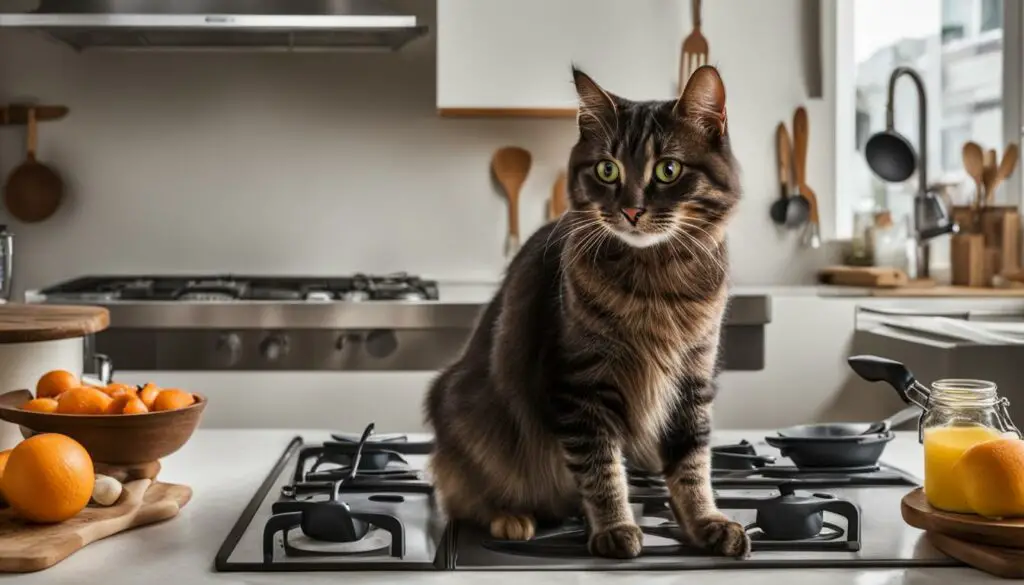
| Consequence | Action |
|---|---|
| Noise deterrent | Use a noise-making device or shake a can filled with coins or pebbles when the cat jumps on the counter to startle them and make the experience unpleasant. |
| Physical barriers | Create barriers using a baby gate or objects to block the cat’s access to the counter. |
| Redirect attention | Immediately redirect the cat’s attention to a more appropriate activity or reward them for behaving appropriately elsewhere. |
| Remove from counter | Gently lift the cat off the counter and say “off” to establish boundaries and reinforce that the counter is off-limits. |
Never Let Your Cat on the Counter
When it comes to keeping your cat off the stove and maintaining a cat-friendly kitchen, prevention is key. By establishing a firm rule of never allowing your cat on the counter, you can create a safe and clean space for both you and your feline friend. Training your cat to stay off the counter may take time and patience, but with consistency and effort, it can be accomplished.
Redirecting your cat’s behavior is crucial in preventing counter-surfing. Provide alternative climbing areas, such as cat trees or designated high spaces, where your cat can fulfill their natural instinct to climb. By offering enticing alternatives, you can redirect their attention away from the counter and stove.
Consistency is key in training your cat. Establish clear boundaries and reinforce them with positive reinforcement. When your cat attempts to jump on the counter, calmly but firmly say “off” and gently remove them from the area. Avoid using physical force or punishment, as this may lead to fear or aggression. Instead, focus on rewarding desired behavior and providing loving attention when your cat chooses to stay off the counter.
Remember to always supervise your cat in the kitchen and create a cat-friendly environment that includes interactive toys, puzzle feeders, and regular playtime. By providing mental and physical stimulation, you can keep your cat entertained and less likely to seek out forbidden surfaces like the counter. With patience and dedication, you can successfully prevent counter-surfing and create a harmonious living space for both you and your cat.
| Training Techniques | Benefits |
|---|---|
| Consistency and reinforcement | Establish clear boundaries and reward desired behavior |
| Providing alternative climbing areas | Redirect attention away from the counter |
| Supervision and interactive play | Create a cat-friendly environment with mental and physical stimulation |
Conclusion
In conclusion, effectively modifying cat behavior and training techniques can help cat-proof your kitchen and prevent them from jumping on the stove. By implementing these methods, you can create a safer environment for your feline friend.
Remember to provide alternative climbing areas, such as cat trees, to satisfy their natural instinct to climb. Spending time with your cat and providing them with attention can also prevent stove-jumping behavior.
Utilizing deterrents like sticky placemats, citrus cleaners, aluminum foil, and blocking common landing areas can discourage cats from accessing the stove. Additionally, removing food from the counters and using puzzle toys for stimulation can distract them from counter-jumping.
With patience, consistency, and a combination of these techniques, you can successfully train your cat and protect their well-being while maintaining a cat-proof kitchen.
FAQ
How can I deter my cat from jumping on the stove?
There are several methods you can try to keep your cat off the stove. Some effective options include using sticky placemats, citrus cleaners, aluminum foil, blocking common landing areas, using cookie sheets, providing alternative climbing areas, spending time with your cat, providing extra stimulation, removing food from the counter, physically removing your cat from the counter, and never allowing your cat on the counter in the first place.
How do sticky placemats help keep cats off the counter?
Cats do not like the feel of sticky placemats, so placing them on the countertop can deter cats from jumping on it. Leave the mats on the counter until the cat stops trying to jump up, then they can be removed.
Can citrus cleaners help keep cats away from the stove?
Yes, cats are often deterred by the smell of citrus. Using a citrus-scented cleaner can keep them away from the stove. It is best to use a cleaner that includes real citrus and not a fake-scented one. You can also make your own citrus cleaner using orange peels or similar ingredients.
How does aluminum foil help prevent cats from jumping on the stove?
Cats do not like the feel or sound of aluminum foil on their paws. Layering aluminum foil on the stove and countertop can deter them from jumping on these surfaces. Remember to remove the foil before using the stove.
How can I block my cat’s favorite jumping spot on the counter?
If your cat tends to jump on the counter at the same spot, you can block it with something like a fruit bowl or by moving objects to the area. This may deter them from jumping on the counter, but some cats may find an alternative spot to jump from.
Can cookie sheets help keep cats off the stove?
Yes, cookie sheets can provide an uncomfortable landing for cats. Placing them close to the edge can create a precarious situation for them, making them less likely to jump on the stove. However, some cats may not be deterred by cookie sheets.
How can I provide alternative climbing areas for my cat?
Cats have a natural instinct to climb, so providing them with alternative climbing areas can prevent them from using the counter and stove as climbing spots. Place climbing structures in a separate room, preferably near windows, and discourage them from using the counter.
What can I do to prevent my cat from jumping on the stove for attention?
Cats often jump on the counter for attention. Spending quality time with your cat and providing them with attention before they start their stove-jumping behavior can prevent it. Meeting their need for attention can eliminate the desire to jump on the counter.
How can I distract my cat from jumping on the counter?
Boredom can lead cats to explore and jump on the counter. Providing them with toys, especially puzzle toys that keep them mentally engaged, can distract them from jumping on the counter. One-on-one playtime can also provide stimulation and prevent counter-jumping behavior.
Should I leave food or other items on the counter?
No, leaving food or anything interesting to a cat on the counter or stove can encourage them to jump up. Clear the counters of any food, leftovers, packaged goods, and dry herbs before leaving the room. Avoid using enticing human foods that can be harmful to cats.
How do I physically remove my cat from the counter?
If your cat jumps on the counter, gently remove them and say “off.” Avoid pushing the cat, as this can lead to injuries. If the cat continues to jump on the counter, physically preventing them from reaching it or placing the cat in a crate or closed room can be necessary. Avoid giving the cat attention for a period of time to discourage the behavior.
Can I train my cat to never jump on the counter?
It is best to never allow your cat on the counter from the beginning. If you have been allowing them on the counter, breaking the habit may be more challenging but not impossible. Replace the counter-surfing habit with alternative behaviors, such as using a cat tree or designated high spaces. Consistency and multiple training methods can be effective in preventing cats from accessing the stove.

